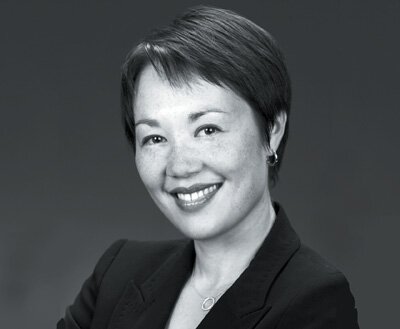| Cantor Angela Warnick Buchdahl - the face of the modern Jew |

|

|
|
People enter every encounter with preconceived notions and prejudices. To the majority of people, Angela Warnick Buchdahl does not look Jewish, but as she explains, “just being who I am forces people to alter their perceptions.†Angela Warnick Buchdahl, though born in Seoul, Korea, is not only an Ashkenazi Jew but she is also the first Asian American to complete the Hebrew Union College rabbinic programme and cantorial programme.She now serves as the Cantor of Central Synagogue in New York.
Cantor Buchdahl’s father is a American Jew and her mother is a Korean Buddhist who met while her father was working in South Korea as a civil engineer. When she was five, her father moved his young family back to his home in Tacoma, Washington. Her identity in those early years was very much Korean until a return visit to her birthplace when she was about 10 years old. There she confronted just how American she had become. With respect to her Jewish identity, while she and her sister were the only Asian faces in the synagogue and in her Jewish camps, there was an acceptance of her as a Jew, as Angela. Although her family was for the most part secular, Angela began a deeper exploration of her own spirituality and urged her family to become ‘more Jewish’. She did not question her own identity as a Jew until a trip to Israel in her late teens. This trip proved to be a turning point for her. There she was confronted with numerous attacks on her Jewish identity, but it is also where she drew her inspiration to enter the rabbinate. She found that she was, “illequipped and ill-prepared to counter such confrontations.†She recalls calling her mother and insisting that she was considering no longer being Jewish anymore. Her Korean mother replied, “Is that something you can do?†It was then that she realised that her Judaism could not be separated from her anymore than the fact that she was Korean or a woman. Her Judaism went to the core of who she was. While in Israel, she learned that, “Being in Israel for me is like being in love. Everything is more intense. Colours are brighter.†The Israel experience however proved to be a ‘mixed bag’. To the Israelis she simply could not be Jewish. For them Judaism was one with their nationality and culture. Her skin, her ‘Koreaness’, told them that she was of another people and could not be one of them. While defi ning her own Judaism, she in turn forced them to ask the question, “What is the basis of your Jewish identity if it is not ground in prayer, belief, and spirituality.†Her mere assertion of her Jewishness was a step towards dispelling the myth that Judaism is based on one ethnicity or one culture. Throughout the rest of her college experience, she went through numerous phases of religious experimentation. She adopted more Orthodox practices to prove to others that she was authentic. She recalls standing before a group, davening an with her head covered and then being asked if she was Jewish. When asked if she had chosen to affiliate with the Orthodox movement, what level of acceptance would she have found there? Cantor Buchdahl responds that she believes that in many ways this would have been the easier route towards acceptance as a Jew. Her Judaism would be defined by the conversion process. In the assimilated/secular world however your Judaism is defined in ways other than your practice. That being said, she identifies with the Reform movement’s ideology. She believes that Reform Judaism is the key to our survival given its flexibility and openness. As a Reform Jew, she was taught that conversion was not even necessary because she had one Jewish parent and was raised as a Jew. She deeply resented questions by Jews as to her authenticity and promised herself that she would not go through the conversion process for them. Cantor Buchdahl soon realised that there is great value in going through the process. She ultimately made the decision to formally reaffirm her Judaism. As she points out, “In today’s day and age, we all are truly Jews by choice.†As Cantor Buchdahl reminds, “We were a mixed multitude when we left Egypt and entered Israel.†Multi-racial diversity is not a new issue to the Jewish people and our diversity increased with our adaptation to life in the Diaspora. She points out that there has been a greater awareness of this diversity as we become an increasingly more global society. Many families today are adopting trans-racially. Additionally, the intermarriage rate is at an all time high and we are witnessing more and more inter-racial and interfaith couples. The rapid increase in the number of Jews of colour, she believes will increase awareness and usher in a new consciousness. While some Jews have purposefully connected to her and her synagogue because she is a Jew of colour, she does not think of herself as a role model. “I just live my life as a Jew in the skin I am in. Once people enter my synagogue and hear me chant, the fact that I am Korean begins to melt away.†She also pointed out that in urban settings, there is already a heightened awareness with respect to racial diversity. She laughs as she says, “My best friend constantly tells me how Jewish I look.†And truth be told, in the course of the interview, after understanding her pure, “authenticâ€, deeply spiritual love for Judaism, she did begin to ‘look Jewish’. She has served on the board of the Jewish Multiracial Network(JMN), an organisation dedicated to creating a community of support for Jews of colour and multiracial Jewish families, and she indicated that the Reform movement was consciously putting a rainbow of faces on their materials. When asked what the mere existence of organisations like JMN says about our acceptance of Jews of colour and our understanding of the diversity of the Jewish people, she reminds that, “we have come a long way in terms of awareness and are just not quite there yet. This is the level where change begins to happen.†And she indicates that the real goal of the JMN and other similar organisations is to no longer need to exist. As American Jews, we enter into countless debates in Synagogue as to whether we are Jewish American or American Jews. She doesn’t see the need to rank identities. To her the fact that she is Jewish, American and Korean is not in conflict with one another, they are merely the parts that make up who she is organically. She points out that we all struggle to define our identity and indicates that her ethnicity and her faith are no more in conflict with one another than one who defines themselves as a feminist and Orthodox, yet they both are forced to justify and rationalise these ‘dual’ identities to others and show that they can be integrated. Cantor Buchdahl admits though that in her journey to embrace Judaism on a deeper level, she lost a bit of her Korean identify along the way. Her three children identify their grandmother as being Korean but not their own mother nor themselves. As the product of a biracial marriage, she looks Korean but as a Jew and an American, what does she do that is Korean? Cantor Buchdahl laughs and comments, “I am Korean in my daily life in the same way an entirely secular Jew is Jewish. I eat Korean food and I tell my children Korean folktales. They use the Korean word for grandmother when referring to my mother.†Cantor Buchdahl is optimistic that society is changing its attitude towards race and ethnicity. She sees a serious shift in worldview beginning to take place. Globalisation has increased the number of transracial adoptions and interracial marriage is on the rise. What will the ethos of the next generation be? What does a Jew look like?  (Issue September 2008) |

















